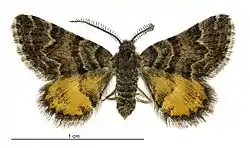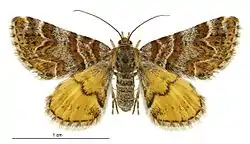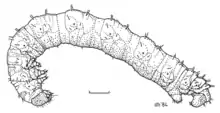Arctesthes catapyrrha
Arctesthes catapyrrha is a moth of the family Geometridae.[2] It is endemic to New Zealand.[3][4]
| Arctesthes catapyrrha | |
|---|---|
 | |
| Male | |
 | |
| Female | |
| Scientific classification | |
| Kingdom: | |
| Phylum: | |
| Class: | |
| Order: | |
| Family: | |
| Genus: | |
| Species: | A. catapyrrha |
| Binomial name | |
| Arctesthes catapyrrha | |
| Synonyms[1] | |
| |
Taxonomy
This species was first described by Arthur Gardiner Butler in 1877 as Fidonia catapyrrha.[5]
Distribution
A. catapyrrha is widespread and is found in open areas from coastal to alpine locations.[6] It has been observed in the Mackenzie Country,[7] Kaitorete Spit,[8] near the Waimakariri River,[8] and in Central Otago.[9]
Life stages
A. catapyrrha is a day flying moth.[10] Adult moths can be seen between October and March.[8][10]
Host species

Arctesthes catapyrrha larva
Larvae of A. catapyrrha feed on Plantago species[3] and on Raoulia australis.[10]
References
- "NZOR Name Details - Arctesthes catapyrrha (Butler, 1877)". www.nzor.org.nz. Landcare Research New Zealand Ltd. Retrieved 8 February 2017.
- Dugdale, J. S. (1988). "Lepidoptera - annotated catalogue, and keys to family-group taxa" (PDF). Fauna of New Zealand. 14: 170–171. ISSN 0111-5383. Retrieved 6 February 2017.
- Craw, R. C. (1986-01-01). "Review of the genus Notoreas (sensu auctorum) (Lepidoptera: Geometridae: Larentiinae)". New Zealand Journal of Zoology. 13 (1): 131–140. doi:10.1080/03014223.1986.10422654. ISSN 0301-4223.
- Patrick, Brian H.; Patrick, Hamish J.H.; Hoare, Robert J.B. (2019-05-29). "Review of the endemic New Zealand genus Arctesthes Meyrick (Lepidoptera, Geometridae, Larentiinae), with descriptions of two new range-restricted species". Alpine Entomology. 3: 121–136. doi:10.3897/alpento.3.33944. ISSN 2535-0889 – via Pensoft.
- Butler, Arthur Gardiner (1877). "On two collections of Heterocerous Lepidoptera from New Zealand, with descriptions of new genera and species". Proceedings of the Zoological Society of London: 379–407 – via Biodiversity Heritage Library.
- Barratt, B. I. P.; Patrick, B. H. (1987). "Insects of snow tussock grassland on the East Otago Plateau". New Zealand Entomologist. 10 (1): 69–98. doi:10.1080/00779962.1987.9722513.
- Patrick, B. H. (1992). "Supplement to the Lepidoptera of the Mackenzie Country with recommendations on their conservation". New Zealand Entomologist. 15 (1): 48–58. CiteSeerX 10.1.1.534.4540. doi:10.1080/00779962.1992.9722629.
- Patrick, Brian (1994). "Lepidoptera of Kaitorete Spit, Canterbury". New Zealand Entomologist. 17 (1): 52–63. CiteSeerX 10.1.1.580.6402. doi:10.1080/00779962.1994.9721985. ISSN 0077-9962.
- Allen, R. B.; McIntosh, P. D. (1995). "Guidelines for conservation of salt pans in Central Otago" (PDF). Science for Conservation. 49: 1–46.
- Macfarlane R.P.; Patrick B.H.; Vink C.J. (1999). McLeans Island: invertebrate inventory and analysis (Report). Christchurch City Council (Parks & Recreation Division) report. pp. 1–44. hdl:10182/4156.
External links
| Wikimedia Commons has media related to Arctesthes catapyrrha. |
| Wikispecies has information related to Arctesthes catapyrrha. |
- Citizen science observations of species
- Specimens held at the Auckland War Memorial Museum
- Image of specimen held at Te Papa Tongarewa Museum of New Zealand
This article is issued from Wikipedia. The text is licensed under Creative Commons - Attribution - Sharealike. Additional terms may apply for the media files.